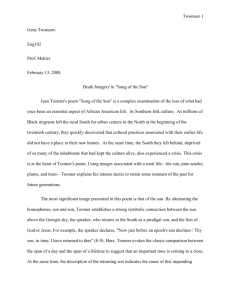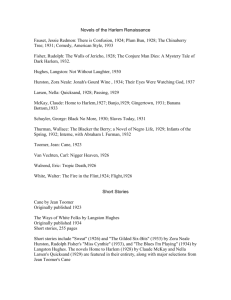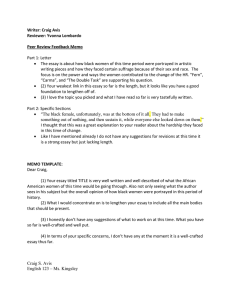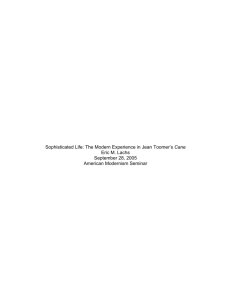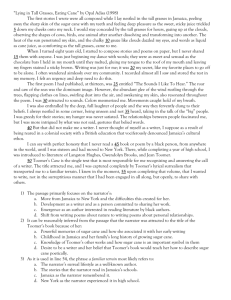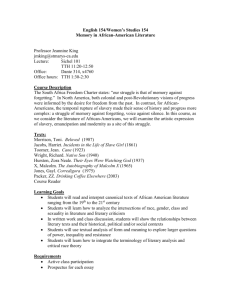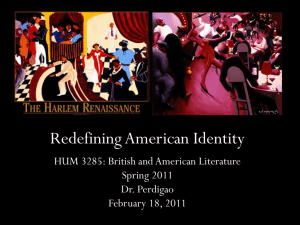Ryan Thomas English 631 Dr. Laura Dawkins Identity in Jean
advertisement
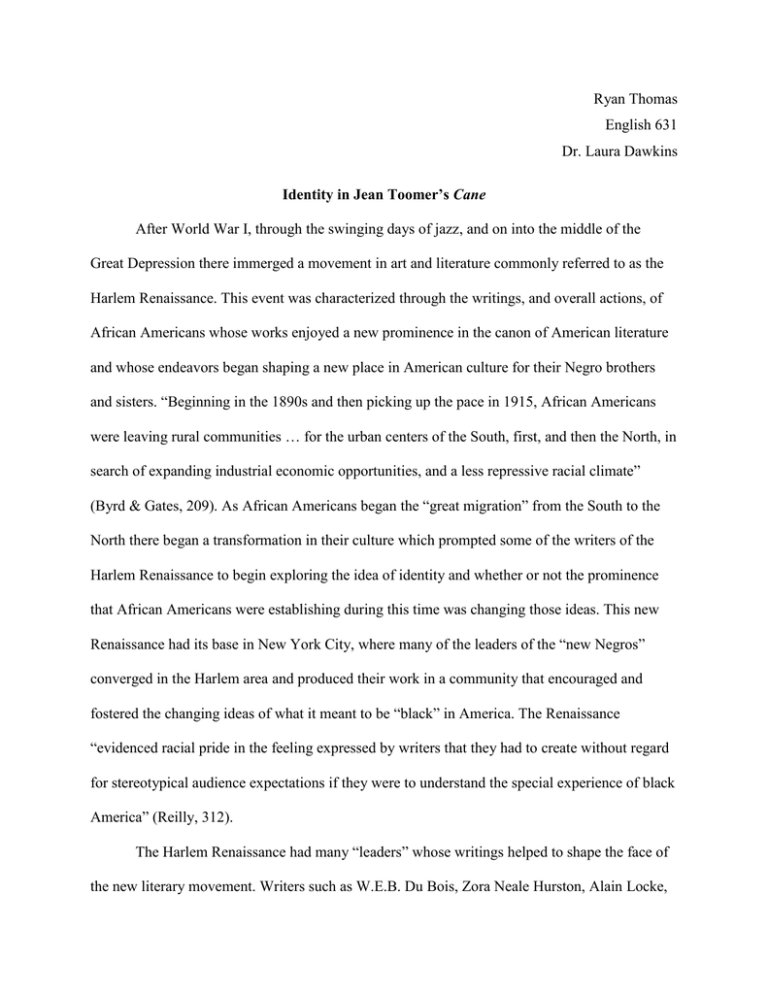
Ryan Thomas English 631 Dr. Laura Dawkins Identity in Jean Toomer’s Cane After World War I, through the swinging days of jazz, and on into the middle of the Great Depression there immerged a movement in art and literature commonly referred to as the Harlem Renaissance. This event was characterized through the writings, and overall actions, of African Americans whose works enjoyed a new prominence in the canon of American literature and whose endeavors began shaping a new place in American culture for their Negro brothers and sisters. “Beginning in the 1890s and then picking up the pace in 1915, African Americans were leaving rural communities … for the urban centers of the South, first, and then the North, in search of expanding industrial economic opportunities, and a less repressive racial climate” (Byrd & Gates, 209). As African Americans began the “great migration” from the South to the North there began a transformation in their culture which prompted some of the writers of the Harlem Renaissance to begin exploring the idea of identity and whether or not the prominence that African Americans were establishing during this time was changing those ideas. This new Renaissance had its base in New York City, where many of the leaders of the “new Negros” converged in the Harlem area and produced their work in a community that encouraged and fostered the changing ideas of what it meant to be “black” in America. The Renaissance “evidenced racial pride in the feeling expressed by writers that they had to create without regard for stereotypical audience expectations if they were to understand the special experience of black America” (Reilly, 312). The Harlem Renaissance had many “leaders” whose writings helped to shape the face of the new literary movement. Writers such as W.E.B. Du Bois, Zora Neale Hurston, Alain Locke, and Langston Hughes are all credited with steering the movement through their work, which explored and celebrated being African American at that time. Many of these authors enjoyed a success that was rare for someone of color up until the Renaissance began to gain traction and their writing and social activism became the focus of the movement. Yet, there was one writer who is credited as having an association with the Harlem Renaissance whose work bears questioning as to whether it celebrated the idea of being African American or whether it sought to explore the idea of transcending racial terms. Jean Toomer’s book, Cane, was one of the first to be connected with the new Harlem Renaissance, but details of whether that was his intention or not have been a recent debate among scholars. Toomer’s book weaves poetry and prose into a rich tapestry that creates images of “black” people in both the rural South and the urban North, but these images are often confusing since many of the characters in them are “white” African Americans. When the book first came out in 1923 it was “hailed by critics for its literary experimentation and portrayal of African-American characters and culture” (“Jean Toomer”), but when set in juxtaposition with Toomer’s life and outwardly expressed views, on not being labeled with a certain race, a case can be made that the author was actually attempting to express his desire for an age when the dividing lines between “black” and “white” Americans could be erased. Instead of relying on the burgeoning Renaissance movement to help his book gain popularity some scholars contest that Toomer actually “took offense at marketing Cane as a work of African American literature” (Harmon, 90). In order to understand why Toomer might have invested Cane with the task of blurring the racial identity lines it is necessary to first look at his life and to understand where the underpinnings of his work had their origins. Washington D.C. was the birthplace of Jean Toomer, who was brought into the world on December, 26 1894 by his mother Nina Pinchback and his father Nathan Toomer “into a family of men and women who, because of their mixed ancestry, could have passed for either black or white” (Byrd, 311). Soon after his birth, Toomer’s father abandoned the family and his mother moved them in with his grandfather in an affluent neighborhood in Washington. Toomer’s grandfather, P.B.S. Pinchback, had been an important political figure after the Civil War, at one time serving as the acting Governor of Louisiana, and had retired to Washington where he lived “the life of a social lion” (Fullinwider, 396). Nina eventually remarried and moved her family to New York but when she died, in 1909, Jean moved back to Washington to live with his grandfather. Jean spent the rest of his formative years in an upper-class African American neighborhood and graduated from the esteemed Dunbar High School. It was during these years when Toomer began to struggle with the conflict of his racial ties as an African American who could have passed as white like some of his family had already done. After Toomer graduated from high school he traveled around the country and entered several different colleges. His studies took him the Wisconsin, Massachusetts, Chicago, and finally to New York, yet his wanderings never resulted in him earning a degree from a higher institute of learning. It seemed that Toomer was searching for something, possibly some place where he felt he belonged, that he never quite came close to finding in his journeys. It was during these years of wandering that he began to extensively read literature and where he eventually found the words to begin his own writing. Because of his ties to both the black and white worlds it was during this time that Toomer also began to grow an aversion to being labeled as either one race or the other and “rather than label himself an Afro-American, or a white American, Toomer dropped the prefix and the adjective, calling himself an American” (Byrd, 314). After his years of travelling, Toomer eventually returned to Washington where he felt “trapped in genteel poverty … caring for two ailing grandparents” (Kodat, 2) and where he “inevitably came face to face with his own limitations and deficiencies as a writer” (Byrd & Gates, 203). During his time back in Washington, Toomer set himself toward practicing his writing in order to refine his skills but after almost a year there he found that “being the sole caretaker of his aging grandparents would … drain him of his energy and focus” (Byrd & Gates, 204) and he realized that a respite would soon be needed. That respite came in the form of an invitation for a temporary job as the principle of a Negro school in Sparta, Georgia, which he accepted. It would be Toomer’s first visit to the South and he welcomed the chance to see where the Afro-American side of his being had arisen. In Sparta, Toomer would finally be able to find an inspiration that would directly lead to his writing of Cane, but there are many who argue about just what that inspiration was. The common assumption during the time of Cane’s publication was that in Sparta Toomer got in touch with his African American heritage and that the three months he spent there caused him to lament the rural, Negro life that he had missed out on in the North. In fact, “Sparta is routinely treated as little more than a backdrop to the soul-searching undergone by a lightskinned, middle-class artist suddenly landed among black rural and small-town folk” (Foley, 748). That Sparta had a direct influence over his writing of Cane is not in contention since the first work produced after his trip, “Kabnis,” is almost a mirror to his firsthand experience there, but the point that is in debate is whether Toomer’s trip to the South reconnected him to his African American heritage or whether it strengthened the belief in a personal identity, neither black nor white, that he had already established before his sojourn to Sparta. Looking at the actual text of Cane holds some insight to which he truly believed. One of the poems in Cane most cited by scholars as the prime example of Toomer’s reconnection to his African American heritage is “Song of the Son” which appears to lament the earth and culture of Negro songs that he had not previously been exposed to growing up in the middle-class North. The poem “seemed to many of its readers to articulate the project of the book as a whole, namely the recovery of the vanishing world of the South by a Northerner who has, at long last, returned home” (Stasi, 145). The poem reads: Pour O pour that parting soul in song, O pour it in the sawdust glow of night, Into the velvet pine-smoke air to-night, And let the valley carry it along. And let the valley carry it along. O land and soil, red soil and sweet-gum tree, So scant of grass, so profligate of pines, Now just before an epoch's sun declines Thy son, in time, I have returned to thee, Thy son, I have in time returned to thee. In time, for though the sun is setting on A song-lit race of slaves, it has not set; Though late, O soil, it is not too late yet To catch thy plaintive soul, leaving, soon gone, Leaving, to catch thy plaintive soul soon gone. O Negro slaves, dark purple ripened plums, Squeezed, and bursting in the pine-wood air, Passing before they stripped the old tree bare One plum was saved for me, one seed becomes An everlasting song, a singing tree, Caroling softly souls of slavery, What they were, and what they are to me, Caroling softly souls of slavery. (17) When first exploring the poem it is easy to see that Toomer did, in fact, elegize the vanishing of some figurative idea, but upon closer inspection there are hints that the author was not discussing the loss of a connection to rural life and instead was celebrating the impending death of the deepheld association to slave-life that still permeated many modern African Americans at the time. When the poem is broken down it is possible to see that, with his words, Toomer might have been attempting to sever the notion that African American identity had to be tied to the past – to slavery. Throughout the poem the idea of letting go, the idea of something ending is prevalent in almost every stanza. The poem begins and ends with the images of song, referencing the songs of slaves that were an identifying marker for African Americans in the rural South, and the middle stanzas all display images of termination. The first stanza gives the initial indication that Toomer was pronouncing the possibility of transcending the slave identity as he begins with an instruction to take the “parting soul” (1), the soul that is leaving, and put it in a song to be carried away on the winds. The “soul” that he speaks of references the essence of how Negros had come to identify themselves that was “parting” or coming to an end. This sentiment is reverberated in the last stanza when he again invokes the image of the “songs of slavery” (21) and intentionally differentiates them between “what they were” (22) and what they now mean to him. Some believed that the slave songs connected African Americans to their past identities so that they wouldn’t forget where they came from but Toomer indicates that he sees them as something different. In the second and last lines of that stanza the “songs of slavery” (21) are transformed into “the souls of slavery” (23) which points out the feeling that Toomer had of the songs keeping African Americans restrained to the past instead of freeing them. The notion of Toomer making a plea to let go of the past is even more evident in the middle three stanzas. In the second stanza of the poem the line “Now just before an epoch’s sun declines” (8) brings forth the idea that a time period is ending, the period where African Americans have to identify themselves with slavery, and that he has returned to just “in time” to see these sentiments for himself before the sun finally sets on these old philosophies. The next stanza takes up the same theme when Toomer says: “…for though the sun is setting on / A songlit race of slaves, it has not set;” (11-12) echoing his idea in the previous stanza about the ideas of identifying with slaves is coming to an end and that he has gotten to experience these attitudes before they are gone. The next stanza ties the preceding two together as Toomer invokes images of pain by calling the Negro slaves “dark purple ripened plums,” (16) summoning to mind the hanging of slaves in the past, and then tempers this image by saying that this identifying image is “passing” (18). Before the image of these strange fruits passed out of the collective conscience, however, Toomer indicates that he was able to witness the image’s effect on African Americans “before they stripped the old tree bare” (18) and that “one plum was saved for me” (19) which planted a seed in him. Some have argued that the “seed” was his identification with his past, but in a letter to Sherwood Anderson he wrote “My seed was planted in myself down there” (Foley, 747), indicating that the seed he spoke of was, in fact, the seed of inspiration that he had been missing in his writing up to that point. “Song of the Son” is not the only example that Toomer uses in Cane to discuss the “ending” of things. The image of dusk, the natural ending of the day, is used several times throughout the first section of the book and is even used to begin the book as a whole. The first story in Cane is “Karintha” which opens with a verse of poetry: Her skin is like dusk on the eastern horizon, O cant you see it, O cant you see it, Her skin is like dusk on the eastern horizon …When the sun goes down. (1) In the very first words of the book we get an image of dusk, setting the tone for the book with a theme that would repeat again and again. In the story itself, Toomer refers to dusk or sunset several times when describing Karintha, likening her both to the beauty of the setting sun and reinforcing the image of the dying of light, of the ending of something. “The portrait of Karintha as dusk assigns her liminal status by alerting readers that what she represents is disappearing” (Williams, 91). Karintha is beautiful and with that beauty comes too-early interest from men and boys which causes her to “ripen too soon” (5), displaying the early ending of her innocence. Other instances of Toomer’s use of dusk comes both in “Carma,” when the narrator first sees her at dusk driving down the road, and in in “Fern” as the climactic moment when the narrator holds Fern in his arms just before she cries out and becomes hysterical. In fact, dusk hides Fern at one point so that he can only hear her singing. Dusk is not the only method that Toomer uses to symbolize the ending/passing of things in Cane. Clues can also be seen in his characters and the way he chose to portray many of his African American individuals as “white.” The female characters in both “Fern” and “Esther” are Afro-American women who Toomer describes as white; Fern – the color of “soft cream” (21) and Esther with her “chalk-white face” (29). Since each of the women are of mixed ancestry they are (like Toomer himself) not able to use their race to identify themselves so they instead turn to sexuality. Fern’s beauty causes her to be used by many men and she eventually becomes “an unconscious wanton” (Williams, 87), whereas Esther’s lack of sexuality eventually causes her to stare “age and bastardy in the face and flee[ ] in despair” (Williams, 87). Also, in the semiautobiographical story “Kabnis,” the lead character is of mixed race and Toomer describes him as having “brown eyes [that] stare from a lemon face” (111). In this way Toomer expressed his idea that racial mixture seemed to be “a natural occurrence when people were freed from inhibitions” (Leverette, 68) and that the era of someone being just “black” or just “white” was passing, or coming to a natural close (much like dusk closes the day). Toomer’s idea of a future where racial lines had blurred to point of nonexistence was not overly shared by his contemporaries and “the idea of biracial persons achieving healthy identities by embracing their multiple ancestry [had] been virtually unthinkable to both writers and critics” (Hutchinson, 688). About Cane, Janet Whyde proffered: “Toomer’s goal is to reconcile and unify these opposites, but to do so, he must collapse the antinomies into mediating forms” (43). By constructing some of his main characters in the book as being light-skinned African Americans, many scholars that Toomer was trying to rectify his own appearance and make sense of where his place in the world should be. Some think that Toomer finally found his roots in Sparta, a connection to the past that he had been looking for, and his use of “white” Negros was his way of connecting himself to those roots. This was certainly the case for many of the other artists connected to the Harlem Renaissance since writers such as Langston Hughes and Zora Neale Hurston made trips to the South, and even Sparta in particular, in an attempt to gain their own inspiration. The idea that Toomer’s trip to Georgia was a catalyst and an inspiration that helped him craft Cane is undeniable, but his use of light-skinned characters, including the surrogate character of Kabnis, was more than juts his attempt to relate to the rural folk that he was trying to capture in his book. In fact, “the book’s emphasis on skin color emerges not so much as a fetishization of race but rather as a foregrounding of the fact of miscegenation, which Toomer hoped would lead to the ultimate version of relational identity: a form of desire that would literally make everyone related” (Stasi, 157). The blurring of dividing lines, both racial and cultural, was not just confined to the first section involving the South but also in the second section where Toomer takes the reader back North to Washington D.C. In the prose-poem "Seventh Street" Toomer hints at the mixing of the races and/or the integration of "black" culture into "white" culture. Using Seventh Street, the dominantly black neighborhood, as his backdrop Toomer attempts to display the intercourse of black and white cultures using the street almost like a character. Money burns the pocket, pocket hurts, Bootleggers in silken shirts, Ballooned, zooming Cadillacs, Whizzing, whizzing down the street-car tracks. Seventh Street is a bastard of Prohibition and the War. A crude-boned, soft-skinned wedge of nigger life breathing its loafer air, jazz songs and love, thrusting unconscious rhythms, black reddish blood into the white and whitewashed wood of Washington. Stale soggy wood of Washington. Wedges rust in soggy wood. . . Split it! In two! Again! Shred it! . . the sun. Wedges are brilliant in the sun; ribbons of wet wood dry and blow away. Black reddish blood. Pouring for crude-boned soft-skinned life, who set you flowing? Blood suckers of the War would spin in a frenzy of dizziness if they drank your blood. Prohibition would put a stop to it. Who set you flowing? White and whitewash disappear in blood. Who set you flowing? Flowing down the smooth asphalt of Seventh Street, in shanties, brick office buildings, theaters, drug stores, restaurants, and cabarets? Eddying on the corners? Swirling like a blood-red smoke up where the buzzards fly in heaven? God would not dare to suck black red blood. A Nigger God! He would duck his head in shame and call for the Judgement Day. Who set you flowing? Money burns the pocket, pocket hurts, Bootleggers in silken shirts, Ballooned, zooming Cadillacs, Whizzing, whizzing down the street-car tracks. (53-54) At that time many whites people were accepting jazz as a musical style and during the Harlem Renaissance many whites could be seen frequenting what, previously, were considered Negro clubs and bars in order to get a taste of the music and nightlife. These "unconscious rhythms" (53) were "thrusting" their way into mainstream culture and the "black reddish blood" (53) was working its way "into the white and whitewashed wood of Washington" (53). Toomer also used this to signify Negro blood seeping into the white society with the intermingling of the races, both culturally and genetically. "Split it! In two! Again! Shred it!...the sun" (53) is talking about how through the generations of interracial births the "black" continued to get lighter and lighter (cut away) until a Negro could be just as white as a Caucasian. Toomer also used the Seventh Street to create an image of a vampire, indicating the cultural side where white people were draining the black culture from the Negros, sucking up the things that set them apart such as their music and style. The vampires ("blood suckers") set the blood flowing, set the Negros on the path toward something less noble than where they came from by turning their desires toward money, booze, and material things such as Cadillacs. “Black opportunists achieve material success on Seventh Street, but they pay the price of self destruction or obliteration” (Whyde, 47). The War sent the African Americans toward the bottle and Prohibition took the bottle away, turning Seventh Street into a cauldron, a perfect amalgamation of forces that transformed the African American culture to a new, but not necessarily better, thing from which others (bootleggers, speakeasy/nightclub owners, musicians, promoters...all vampires supping from the monster that Seventh Street had become) sustained themselves. These notions of identity in Cane have been contested over and over since it was released to the public in 1923.African Americans, especially those connected to the Harlem Renaissance movement, hailed the book as a triumph that displayed the Negro identity. To these writers and activists the book “epitomized the desire among black artists to deal with folk experience in sophisticated literature” (Reilly, 324). This was mainly accomplished, not by Toomer himself, but by many of the people that he considered friends. Toomer’s friend, Waldo Frank, had been asked to write the foreword to Cane, and in his words he referred “to Toomer as ‘the gifted Negro’ and ‘an American Negro’ … undermining his desire to position himself publicly as a writer ‘neither white nor black’” (Byrd & Gates, 221). The author’s publishers, Liveright, also had a hand in his work being marketed to African Americans, and was met with the fact that Toomer “refused to cooperate with Liveright, notwithstanding the risk that his refusal might jeopardize his book’s publication” (Byrd & Gates, 223). The reason for Toomer’s resistance to have his book labeled as “Negro literature” was a simple one – Jean Toomer didn’t believe in identifying himself with any specific race. Well before travelling to Sparta and writing Cane, Jean Toomer had been a man in search of an identity – some sort of unity of his self. The years he spent travelling from college to college reflected the wanderlust he felt at an early age and gave a physical manifestation to this search for something with which to identify himself. “Toomer struggled with claiming an identity,” writes Tru Leverette, “that incorporated his full heritage and preserved his Americanness during a time when being purely ‘American’ meant being whitewashed by the denial of ethnicity” (61). Like many other mixed-race individuals of the time, Toomer was generally expected to make a choice between either being classified as a light-skinned Negro or to go completely in the other direction and “pass” into being a white person. Yet, Toomer resisted being classified as either race and was insistent, both before and after Cane was published, that he never had to “pass” because he never had to try and be white or black and that people just accepted him as he was. “Toomer’s personal experience, then, suggested to him the inadequacy of the visual as a means of understanding identity and led to subsequent decoupling of the external from the internal” (Stasi, 162-163). So then where was Toomer to find his identity if he refused to be classified by either of his races; where to find a place of unity while contending that he had no accepted place except one yet to be determined? How could he ever settle into one comfortable place if he refused to consent to a classification? Toomer’s vision of being a “new” American who was part of all races had yet to come to fruition and with Cane being misrepresented and taken solely as a piece of Negro literature the author had to look elsewhere for his sense of identity. If racial acceptance couldn’t provide the answer to Toomer’s quest for unity, then he decided that religion could. “Toomer found what he was looking for in [George] Gurdjieff’s philosophy – an interesting blend of Freudian categories and religion – became a disciple and spent many of his summers in Fontainebleu” (Fullinwider, 400) at the French Gurdjieff Institute. By 1926 he had given himself wholly to spreading Gurdjieff’s work in America and his writing after that point was bland and didactic and the success of Cane was never again realized. “As Toomer passed into Gurdjieff’s world, he passed into literary obscurity” (Byrd & Gates, 230). To this day Jean Toomer remains almost an anti-hero, in the Byronic sense, to African American liturgists; a writer who touched so eloquently upon the sense of Negro self in Cane, only to later reject the work because it was not received in the manner in which he wished it to be. A man who was ever searching for something to help him coalesce the disharmony within himself and find some sort of identity, some sort of comfortable space, from which he could face the world. A man who, for a brief time, seemed as if he had found some sort of unifying rootsystem while in the rural South of his ancestors which caused his literary creativity to blossom and bring forth the fruit of Cane. Yet, even his as he wove the linguistic tapestry of his signature work together, the picture that he saw was not the picture that readily presented itself to others and he was once again left defending his stance of racial neutrality. There is no denying that Cane had a vast impact on African Americans, especially those involved in the Harlem Renaissance movement, and embodied a search for identity – yet in Toomer’s mind that identity was not tied to a connection to a particular race but, rather, a rejection of racial classifications altogether. Whether black, or white, or somewhere in the indefinite gray area in between, many people can agree that Toomer’s book remains a song of exploration, still drifting out over smokey canefields searching for a place to belong – a place where an identity can be found. Works Cited Byrd, Rudolph P. “Jean Toomer and the Afro-American Literary Tradition.” Callaloo, No. 24 (Spring - Summer, 1985), pp. 310-319. JSTOR. Web. 4 Dec. 2013. Byrd, Rudolph P. & Henry Louis Gates, Jr. “‘Song of the Son’: The Emergence and Passing of Jean Toomer.” Afterword. Cane. By Jean Toomer. New York: Liveright Publishing Corporation, 2011. 161-237. Print. Foley, Barbara. “Jean Toomer’s Sparta.” American Literature, Vol. 67, No. 4 (Dec., 1995), pp. 747-775. JSTOR. Web. 4 Dec. 2013. Fullinwider, S. P. “Jean Toomer: Lost Generation, or Negro Renaissance?” Phylon, Vol. 27, No. 4 (4th Qtr., 1966), pp. 396-403. JSTOR. Web. 4 Dec. 2013. Harmon, Charles. “Cane, Race and “Neither/Norism.” The Southern Literary Journal, Vol. 32, No. 2 (Spring, 2000), pp. 90-101. JSTOR. Web. 4 Dec. 2013. Hutchinson, George B. “Jean Toomer and the ‘New Negros’ of Washington.” American Literature, Vol. 63, No. 4 (Dec., 1991), pp. 683-692. JSTOR. Web. 4 Dec. 2013. "Jean Toomer." The Poetry Foundation. N.p., n.d. Web. 4 Dec. 2013. Kodat, Catherine Gunther. “To ‘Flash White Light from Ebony’: The Problem of Modernism in Jean Toomer’s Cane.” Twentieth Century Literature, Vol. 46, No. 1 (Spring, 2000), pp. 1-19. JSTOR. Web. 4 Dec. 2013. Leverette, Tru. “New Americans: Race, Mixture, and Nation in the Work of Jean Toomer and José Vasconcelos.” South Atlantic Review, Vol. 73, No. 3 (Summer 2008), pp. 61-85. JSTOR. Web. 4 Dec. 2013. Reilly, John M. “The Search for Black Redemption: Jean Toomer’s Cane.” Studies in the Novel, Vol. 2, No. 3 (fall 1970), pp. 312-324. JSTOR. Web. 4 Dec. 2013. Stasi, Paul. “A ‘Synchronous but More Subtle Migration’: Passing and Primitivism in Toomer's Cane.” Twentieth Century Literature, Vol. 55, No. 2 (Summer 2009), pp. 145-174. JSTOR. Web. 4 Dec. 2013. Toomer, Jean. Cane. New York: Liveright Publishing Corporation, 2011. Print. Williams, Jennifer D. “Jean Toomer’s Cane and the Erotics of Mourning.” The Southern Literary Journal , Vol. 40, No. 2, Special Issue: History, Memory, and Mourning (Spring, 2008), pp. 87-101. JSTOR. Web. 4 Dec. 2013. Whyde, Janet M. “Mediating Forms: Narrating the Body in Jean Toomer’s Cane.” The Southern Literary Journal, Vol. 26, No. 1 (Fall, 1993), pp. 42-53. JSTOR. Web. 4 Dec. 2013.
